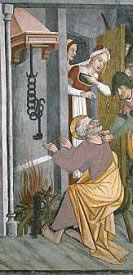
Crémaillère [kʀemajɛʀ] nf – trammel (chem.), rack (rail).
Etymology: from the Old French cramail, from Latin cramaculus (rack), from the Greek kremasti (suspend).
The French word crémaillère came up last night when I mentioned that I’m planning to have a housewarming party, the French equivalent of which is pendaison de crémaillère and pendre la crémaillère means “to have a house-warming party”. This word also features in the phrase for a rack or cog railway: chemin de fer à crémaillère, and engranage/direction à crémaillère is rack-and-pinion gear/streering.
The French version of the housewarming party originates in the Middle Ages when people cooked on open fires with pots suspended from a crémaillère (trammel). The crémaillère was usually the last thing to be installed in a new house, and once it was, people held a party to thank family, friends and all those who had helped them with the new house. This was known as a pendaison de crémaillère (hanging of the trammel) [source].
According to Wikipedia, the custom of having a housewarming party dates back to pre-central heating times when guests brought firewood and built fires in all the fireplaces in a new house in order to warm it. This was thought to chase away any evil spirits in the vicinity, which liked to take up residence in unoccupied houses. Apparently there was a custom of bringing gifts of bluebirds, which were thought to bring good luck and happiness to the new house.
Traditional housewarming gifts in countries such as Austria and Russia apparently include bread (to never go hungry), salt (so life is always full of flavour, or for long life), and a broom (to sweep away troubles) [source].
Do you have any housewarming traditions?
Do you have a party, hold a party, throw a party, or use another verb?
Housewarming in other languages seems to roughly translate as ‘moving-in party’ (German: Einzugsfeier) and ‘initiation/entrance party’ (Dutch: inwijdingsfeest) and Swedish inflyttningsfest. I saw in a Mennonite Low German (Plautdietsch) dictionary the term ‘Fenstakjast’ for housewarming which looks like it means ‘window-gift’?
The pot suspended by the crémaillère Brits and Anglophiles will instantly recognise what the French call a ‘marmite’ being in English the familiar brand name of a yeast and vegetable extract spread akin to the characteristically Australian Vegemite.
In Finnish housewarming is called tupaantuliaiset which means something like arriving in the house party. In colloquial Finnish the short form tuparit is used instead.
And similarily the Swedish speakers in Finland use the swedefied form tupare.
Cremallera is zip or zipper in Catalan and Spanish.
That’s very cool, though regrettably Americans typically don’t do anything like this. Best you can hope for is some neighbors to come over with baked goods to welcome you to the neighborhood when you first move in, and this is something I’ve only heard about happening occasionally, not something I’ve actually witnessed, lol…
Cheers,
Andrew
Andrew:
Seems to me that it’s still common if someone is moving to a new house near friends; they’ll invite the friends over. What’s not common is to invite the brand-new neighbors over.
Just a minor point: it’s _engrenage_ not _*engranage_. 🙂
I find it strange that the French name for the rack-based adjustable pothook “crémaillère” and the English name “trammel” should look so similar, when they have completely different etymologies — or at least “trammel” does in its fish-entrapment / obstacle sense (seen in “untrammelled”).
crémaillère < MF cremalia < OF cramail < VL cramaculus < L cremasculus < Gk kremastér ("that which suspends")
trammel < MF tramail < L tremaculum ("three-meshed object")
Could it be that English kitchens once had "crammels" that later became "trammels" through confusion with horse shackling equipment which also involved chains?